View in other NatureServe Network Field Guides
NatureServe
Montana
Utah
Wyoming
Idaho
Wisconsin
British Columbia
South Carolina
Yukon
California
New York
Alfalfa Looper Moth - Autographa californica
General Description
The alfalfa looper (
Autographa californica) is medium-size (36-42 mm wingspan) grey-black moth with a silvery sheen and slight purplish cast in fresh specimens. Forewings are mottled pale grey in the basal and subterminal areas, with dark blackish-brown in the lower median area and along the subterminal line. The antemedian and postmedian lines and the area below the stigma are dark red-brown. The stigma (reniform spot) is fish-hooked shaped, silvery white, forms an outward curving arc with a rounded tip, and has a widely separated fork at the upper end. About one-third of the way down the subterminal line is a black dash which connects the subterminal and postmedian lines. Hindwings are dark sooty brown-black, paler in the basal half and shading into a wide dark terminal band. The antennae are simple and both the sexes are alike (Anweiler and Robinson no date).
Alfalfa Looper larvae are green with three pairs of white lines on the back, crawls by arching the body, and are 1 to 1.5 inches long when mature. Alfalfa Looper eggs are similar to those of the bollworm in that they are spherical with ridges radiating from top to bottom. However, Alfalfa Looper eggs are more flattened and have finer ridges radiating from the top to the bottom (Powell and Opler 2009).
Phenology
In the province of Alberta, adults are collected occasionally in late May, but the main flight is from late July through October. There is a small spring emergence and a much larger late summer and fall generation. There are several flights in the southern part of its range throughout the growing season, and one flight in the northern part of it range during mid- to late summer (Anweiler and Robinson no date).
Adults are both nocturnal and diurnal, and have been collected in light traps as well as while nectaring during the day. In late fall, they can be quite common and found nectaring during the afternoon at late blooming plants such as alfalfa and garden marigolds (Anweiler and Robinson no date).
Diagnostic Characteristics
About one-third of the way down the subterminal line is a black dash which connects the subterminal and postmedian lines. This black dash is diagnostic and will separate A. californica from the very similar A. pseudogamma (Anweiler and Robinson no date).
Range Comments
The Alfalfa Looper is a widespread, common western species. It is found from northern Mexico to Alaska, east to Manitoba, South Dakota, Kansas and New Mexico. The common habitat is open meadows, hayfields, croplands, gardens and woodland edges (Anweiler and Robinson no date).
Observations in Montana Natural Heritage Program Database
Number of Observations: 136
(Click on the following maps and charts to see full sized version)
Map Help and Descriptions
Relative Density
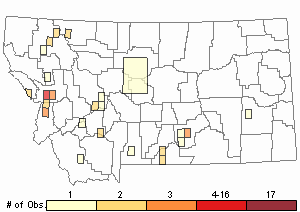
Recency
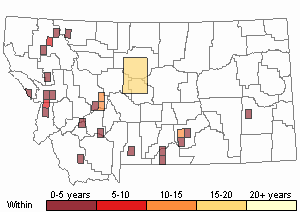
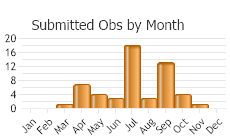
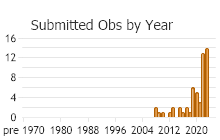
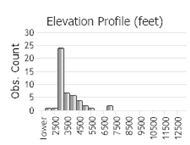 (Observations spanning multiple months or years are excluded from time charts)
(Observations spanning multiple months or years are excluded from time charts)
Food Habits
The larvae feed on a wide range of plants. Recorded food plants are Apiaceae, Aquifoliaceae, Asteraceae, Boraginaceae, Brassicaceae, Caprifoliaceae, Chenopodiaceae, Cucurbitaceae, Ericaceae, Fabaceae, Grossulariaceae, Liliaceae, Lamiaceae, Linaceae, Malvaceae, Plantaginaceae, Poaceae, Podocarpaceae, Polygonaceae, Rhamnaceae, Rosaceae, Rutaceae, Scrophulariaceae, Solanaceae, and Verbenaceae species (Berry 1998).
Stewardship Responsibility
Threats or Limiting Factors
Many predators and parasites combine to substantially maintain Alfalfa Looper populations at low levels. The eggs and small larvae are attacked by bigeyed bugs, minute pirate bugs, and other predators. Trichogramma parasites kill the eggs, and several other parasites, especially Hyposoter exiguae and Copidosoma truncatellum, attack the larvae. The Alfalfa Looper is also subject to a nuclear polyhedrosis virus that can reduce populations rapidly (California Integrated Pest Management Program 2013).
References
- Literature Cited AboveLegend:
 View Online Publication
View Online Publication Berry, R.E. 1998. Insects and mites of economic importance in the Pacific Northwest. 2nd edition.
Berry, R.E. 1998. Insects and mites of economic importance in the Pacific Northwest. 2nd edition. California Integrated Pest Management Program. 2013. UC Management Guidelines for Loopers on Tomatos. Agriculture and Natural Resources, University of California
California Integrated Pest Management Program. 2013. UC Management Guidelines for Loopers on Tomatos. Agriculture and Natural Resources, University of California Powell, J.A. and P.A. Opler. 2009. Moths of Western North America. University of California Press, Berkeley, CA. 369 pp.
Powell, J.A. and P.A. Opler. 2009. Moths of Western North America. University of California Press, Berkeley, CA. 369 pp.
- Additional ReferencesLegend:
 View Online Publication
View Online Publication
Do you know of a citation we're missing? Martin, S. 1933. Serological studies of moth proteins with special reference to specific immune bodies and their phylogenetic significance. M.Sc. Thesis. Bozeman, MT: Montana State College. 26 p.
Martin, S. 1933. Serological studies of moth proteins with special reference to specific immune bodies and their phylogenetic significance. M.Sc. Thesis. Bozeman, MT: Montana State College. 26 p. Sater, S. 2022. The insects of Sevenmile Creek, a pictorial guide to their diversity and ecology. Undergraduate Thesis. Helena, MT: Carroll College. 242 p.
Sater, S. 2022. The insects of Sevenmile Creek, a pictorial guide to their diversity and ecology. Undergraduate Thesis. Helena, MT: Carroll College. 242 p.
- Web Search Engines for Articles on "Alfalfa Looper Moth"
- Additional Sources of Information Related to "Insects"





